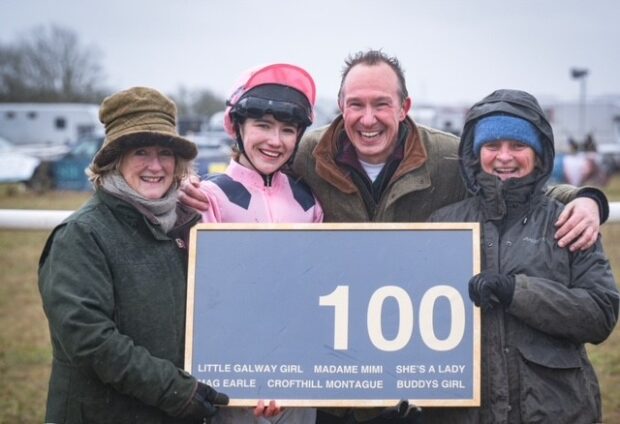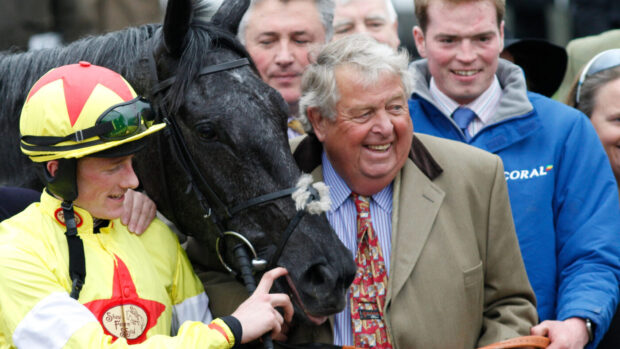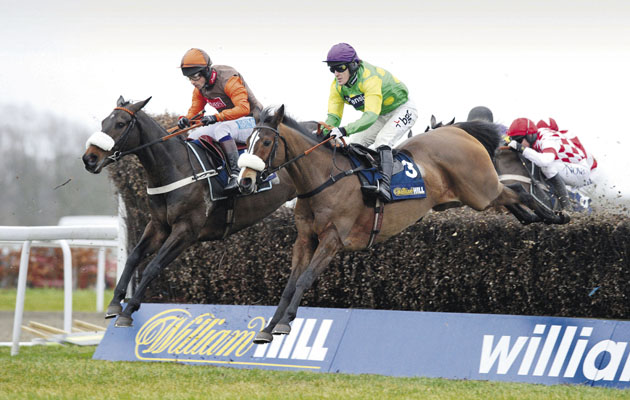From a canteen in the changing room to surviving a deluge of rain on course, H&H's Hannah Lemieux spends the day at Wincanton racecourse and discovers all the action behind the scenes
With attendance at racecourses breaking the six million barrier last year, record number of people are enjoying days at the races. But not many will know what goes on behind the scenes and what it takes for a raceday to run smoothly.
Ahead of Wincanton’s Kingwell Hurdle Day (20 February), I join the team at the Somerset track during a weekday meeting and find out what really goes on — both in the depths of a racecourse weighing room and out on the course.
Wincanton racecourse is popular not only with spectators in the south-west but also the area’s top trainers including champion trainer Paul Nicholls and Colin Tizzard. The number of racedays has increased to 16 meetings over the years — all held between October and May, meaning it is now a busy period for the team who make the racedays happen.
Breakfast time
The day begins with a tasty cooked breakfast courtesy of Anita Buckling, who also oversees the jockeys’ canteen too. I join clerk of the course, Barry Johnson, over breakfast as we get fuelled up for the day.
Wincanton has been one of the more fortunate racecourses to have survived a recent deluge of rain. Barry was out on the course at 7am and has given the raceday the green light.
“Today we have survived the bad weather and there is no waterlogging. Other racecourses have not been so lucky,” says Barry, who has been at Wincanton for eight years but is also clerk of the course at Exeter racecourse — having worked his ways up the ranks there for 35 years.
“Today two fences have been taken out because of a boggy patches around the course. We have a weather station and the rain is measured at specific points around the course so we know exactly how much rainfall there has been,” he adds.
“Our big days at Wincanton include Boxing Day and the Kingwell Hurdle but I treat every raceday the same. The priority is always to make sure the course is safe for both horse and jockey.”
Setting up
By 9am preparations are well under way at the racecourse, as people busily go about setting up for the day before gates open at 11.30am.
Today in the Kingwell restaurant, which overlooks the paddock, there are 55 booked for lunch — many of whom are annual members. On a big raceday the room can hold up to 150 people. There are also 13 private boxes in total.
Not for the faint-hearted
Huw Williams, the racecourse general manager, briefs the stewards who will be manning the gates and entrances.
“There has been four millimetres of rain in 48 hours and the going on the track is not for the faint-hearted,” he tells them. “Today we have 53 runners and 2,000 racegoers are expected.”
At 11.30am, I join Barry on a coursewalk with head groundsman James Martin, Richard Linley, the senior inspector of courses for the British Horseracing Authority (BHA) and the racecourse chairman Jo Hepburn (pictured below).

It is a miracle the course has survived the recent rainfall and the chase fences have been moved to the left by four yards — so the course runs on fresh ground from the previous raceday.
“Patchy ground is the worse type of ground to have, which is why we have decided to omit two fences because of the boggy patches,” explains Barry. “It is worse for horses to go from soft ground to even softer ground and then back on soft ground.”
James and his team of groundsmen have been busy during the week building up to the raceday doing final preparations to the track — levelling it out using a soil and sand mixture and also adding more spruce to the chase fences to bulk them up. They have been doing everything within their powers so today can go ahead and make sure it is safe for both horse and jockey.
“You can never beat nature, you just have to find a way to work with it,” says Richard Linley.
Barry tells me that the hurdle track also gets fresh ground, every two meetings. The upheaval of these substantial fences takes a whole day.
Half-naked jockeys
Back in the warmth and dry of the weighing room, Barry gives me a tour of all the areas where the real behind-the-scenes action happens.
The entrance of the weighing room is where the scales, for weighing-out and weighing-in, are located. Although now updated with an electric one, the traditional one still remains and has been known to come in handy during a power cut on raceday. Feeling paticularly brave I have a sit on them myself (pictured top).
One of the first things the trainers do when they arrive is head to ‘Declarations’ where they declare their runners for the day (pictured below).
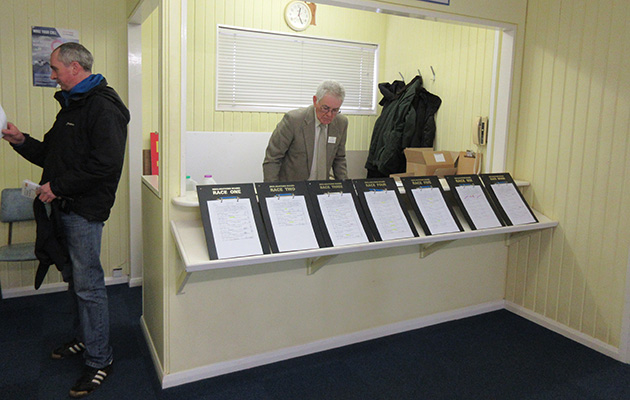
I have a quick peak inside the jockey changing room before it is filled with around 30 half-naked jockeys. There are two — one for the lady jockeys and another for the men, the latter is considerably larger (pictured below).
The valets, who are responsible for cleaning all the gear and ensuring the jockeys’ equipment is transported between racecourses, arrive at about 10am. They start setting up and putting the correct saddles and gear on the right jockey’s peg.
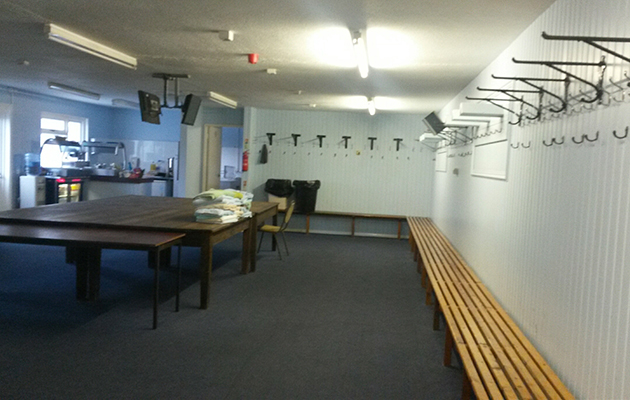
There is also a washroom, a shower room and sauna. In the corner of the changing room is a small canteen. Spencer is in charge of keeping the jockeys fuelled today. He has come to know what the jockeys like to eat and drink including chicken wraps, fruit, sweets and energy drinks.
Outside the changing room, there is a magnetic map of the racecourse outlining where each fence is and where the rails are placed. This is updated on raceday by Barry and means the jockeys can see where both the hurdle and chase tracks run — as a number won’t walk the course.
Adjacent is the ‘Medical room’. The doctor and a nurse arrive 90 minutes before the first race. If a jockey has a fall, they must be checked over by the doctor and be signed off on the database, which is kept by the BHA.
Barry also shows me into the ‘Stewards room’, this is where all the decisions are made. There are two BHA stewards on raceday called stipendiary stewards, as well as two voluntary stewards who are not from the BHA. The “stipe” stewards’ role is to interpret the BHA rules for the voluntary stewards.
If an issue comes before the stewards, all the stewards will discuss the issue before the voluntary stewards relay the information to the jockeys involved.
In the stewards room there are four TV screens, showing different angles including head on, side and rear view.
The jockeys will be called into the Stewards room and the incident will be watched on TV and discussed. The jockeys then leave before a decision is made and the jockeys are informed.
Best turned out
The first race kicks off at 1.30pm and runners start to come into the paddock ahead of it.
TV presenter Luke Harvey hands me an envelope containing £50 and asks if I want to choose the best turned out. I don’t have long to choose as the bell goes for the jockeys to get on — it is not an easy task for someone indecisive like me, but in the end I opt for a handsome bay horse with an immaculately plaited tail. I hand over the envelope to the winning stable lass.
At the start
For the following race, I pile into a car with today’s starters, Simon McNeil and Will Jordan as we drive down to the start.
Today Will is starting and Simon is ‘whipping-in’ — standing behind with a whip to encourage any tricky horses to jump off.
As the horses arrive at the start, Simon and Will check girths (pictured below) and equipment, before horses and jockeys walk into start — it is now a requirement that jockeys walk their horses in towards the starting tape.

During each race, a vet, doctor, ambulance and the grounds team truck all follow the runners on the inside of the course. In the back of the latter are screens incase there is a fallen horse or jockey who need privacy. There is also equipment should a fence need quickly repairing. The grounds team are also on hand to catch any loose horses on the course.
An important role
Clerk of the scales, Graham Ford, invites me to join him at the table (pictured below) in front of the scales, where I watch him do the important job of weighing-out and in the jockeys. His role is to make sure they are riding at the required weight for the race.

Each race has a speadsheet that Graham updates and this is sent to the BHA and the handicappers also have access to the documents.
“Jockeys can weigh-in [after a race] up to and including 1Ib lighter than they weighed out, and they can weigh-in up to 2Ib heavier than they weighed out — they are the allowances,” Graham explains.
During the raceday Graham will decide how many jockeys need to weigh in after a race.
“Some races it will just be the placed jockeys that need to weigh-in but there has to be one ‘all weigh-in’ per day. The jockeys get told on the door if this is the case and whether they need to weigh in.”
The weighing has to be accurate. The jockeys get a 2Ib allowance for the body protector but in jumping — particularly in heavy going — one pound can be the difference between winning and losing.
“It is not that unusual for jockeys to have to declare overweight, it probably happens a couple of times a week,” adds Graham.
The final decision
For the final race, I venture up to the ‘Judge’s box’ with today’s judge Guy Lewis (pictured below). There are two screens for Guy to watch on, while a colleague upstairs swiftly provides him with the photo finish picture if required.
Upstairs there are two cameras, one films the nearside action and the other films the reflection off a mirror — that is placed on the far side of the finishing line and captures the far side action. It means Guy can see both angles of a finish. He will then announce the result over the racecourse tannoy.
Guy has the final decision when it comes to final placings but connections and jockeys can appeal that decision.

With the last race done and dusted and all the horses and jockeys back in one piece, the packing up and clearing commences for the hard-working Wincanton team. It has been a long day but very enjoyable.
I have been given a fortunate insight into the side of racing few spectators get to see. With this raceday finished and a success, the following morning all eyes will turn to their next big raceday and preparations will begin all over again.


